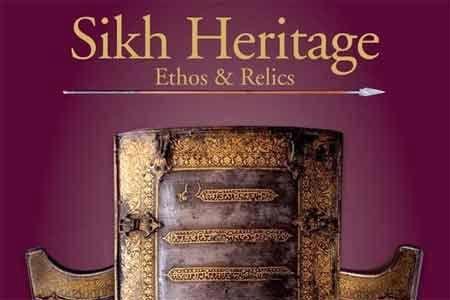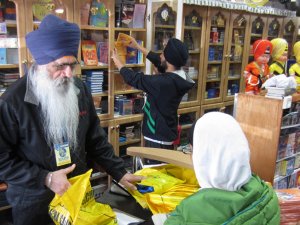 SIKH
HERITAGE: Ethos & Relics
SIKH
HERITAGE: Ethos & Relics
Bhayee Sikandar Singh & Roopinder Singh
xvii + 204 pages, 2012, Price Rs. 1500.00
Rupa Publications, Rupa Publications India Pvt Ltd, New Delhi 100 002, INDIA
A specially gilded edition is available outside India through the Sikh Heritage Foundation, 485 Colliers Way, Weirton,WV 26062, [email protected] ($100.00)
Reviewed by: I.J. Singh
This book is the product of a five-year collaborative effort by the two authors. Full disclosure: I admit with pleasure that I have known the authors for years – Bhayee Sikandar Singh through my association with Nishaan magazine; Roopinder Singh as a friend for about 25 years who has reviewed my books and I have reviewed some of his as well. Also, a blurb by me graces the back cover of this book.
Whether human social units are small as families and neighborhoods, large as countries with political borders, or secular and religious entities, relics and heritage define them; in fact, they are the glue that binds communities and gives them structure and identity. Artifacts and relics connect people; they create and preserve history.
There are many milestones in the relatively young 544 year old Sikh presence in the world. Historical narratives of a people take their life from relics and heritage. No history is a linear trek; there are many vicissitudes, turns, twists in the road, cul-de-sacs and pitfalls in the road. Sikhs have had more than their share in our eventful story; it adds richness to our existence.
The ten Founder-Gurus of Sikhism spanned two and a half centuries – from 1469 when Guru Nanak was born in a part of Punjab that is now in Pakistan to 1708 when Guru Gobind Singh breathed his last. The Gurus traveled widely across the Indian subcontinent, at times beyond its borders; memorabilia of their visits and their influence pervade the Indian countryside, transcending borders of language and culture.
Many of the heirlooms dating from the Guru period that are highlighted in this volume are now owned by families with long-standing, centuries-old connections to the Sikh way of life. Many have preserved the relics with unmatched love and devotion; a few have neglected them because of ignorance of their value. Even though history is found in them, not many relics have been exhibited and discussed in public forums. Sikandar Singh’s family is singularly rich with such artifacts and now, with the collaboration of Roopinder Singh, has brought the treasure trove out into the sunshine of public display.
Both families have been equally known for their long-term dedication to Sikhi and for their collections of Sikh memorabilia. For instance, Sikandar Singh’s ancestors became Sikh in the early 1600’s in the time of Guru Hargobind and the connection continues through the many collectables that the Guru gifted to the family. Their availability today creates a narrative that informs us. Roopinder’s father, the late Giani Gurdit Singh, was a respected scholar of Sikh scriptures besides being a well-known Punjabi author.
In a particularly cogent Introduction, Paul Michael Taylor, Director of the Asian Cultural History Program at the Smithsonian Institution in Washington DC, traces the story of this seminal project from the first discussions (with the participation of the West Virginia based Sikh Heritage Foundation) at America’s national museum, the Smithsonian, in 2003, in which scholars from India and North America participated. Some of the heirlooms in this volume were exhibited and highlighted at the Smithsonian lectures.
As Taylor became more intimately involved with the collection and its possibilities, both in the United States and in India, it was natural that he would suggest to Sikandar the possibility of a book. He did and I, therefore, without hesitation and with singular appreciation, dub Paul Michael Taylor the midwife to this excellent work – a collector’s dream, way beyond a coffee table book.
The text is mercifully without the cobwebs and pontification that are the hallmarks of much religious writing, no matter what the religious label. Religions are products of a people, time and place, hence this context of historical and socio-cultural realities must always be front and center in describing a people and their faith. Although born amidst the clash of civilizations of Hinduism and Islam, Sikhism was and remains a smaller but dynamic third way. This theme is competently developed here in a well annotated and footnoted presentation and it therefore provides a wonderful framing for the religious relics and memorabilia that are the kernel, the meat, of the project.
The historical socio-cultural framework is maintained throughout the book which is divided into two sections, Ethos and Relics. The bios of the ten Gurus are brief but informative. The two-century development of the Sikh movement is sketched well. The evolution of Sikhism from Guru Nanak to Guru Gobind Singh is ably traced, as is the development of the Sikh scripture (Guru Granth).
The story moves seamlessly to the post-Guru period, the times of Banda Bahadur and Maharaja Ranjit Singh; the Anglo-Sikh wars, the Sikh struggle for self-governance of the historical gurduaras and shrines, the Gurduara Reform Movement, The Singh Sabha movement, and finally into the recent past – the movement for independence from the British in which Sikhs had such a momentous role, far in excess of their population.
In summary, the Ethos section is a coherent story of the Sikhs told briefly but well. The people who made a difference find a place therein – men like Max Arthur Macauliffe and C.F. Andrews , Giani Ditt Singh, Bhai Kahn Singh Nabha, Captain Ishar Singh, and many others. Even the infamous General Dyer, who was the architect of the 1919 massacre at the Jallianwala Bagh and Mahant Narain Das, the corrupt caretaker of the birthplace of Guru Nanak are not neglected.
The crown jewels of this book, however, are the heirlooms and relics of Sikh heritage.
Locating relics from several hundred years ago is no easy matter. The land and people go through many changes; time, wars and pestilence take their toll, as do familial break downs and rivalries that surface everywhere. Where political strife is normal, relative poverty abounds and powerful institutions like the Catholic Church do not exist, collection and preservation of memorabilia takes a back seat; in fact, it needs a miracle. Many of the relics are no longer in the keeping of Sikh individuals or institutions. Some are now in Pakistan, either individually held by Muslim families or in the care of government institutions. Many of the items highlighted in this book are not easily available to be viewed.
In this collection each item carries an explanatory note. There are paintings from that period, and items of personal use of the gurus — phulkaris and garments with their intricate designs, metal work, utensils from langar, old cots and many weapons, etc. And then, of course there are the handwritten documents that we need to value and preserve before time takes its toll and destroys them.
In this work we do have a miracle. This book depends primarily on the Bagrian family collection and also draws on the treasures held by many renowned families of the time and rulers of many quasi-independent states in the Indian subcontinent like Patiala and Nabha who were connected through historical and social ties with the Bagrian family.
The family of Sikandar Singh displays an unbroken line from the time Rup Chand came to the court of Guru Hargobind in the early17th century. He and his family became Sikhs and the intimate contact has remained ever since. And the Gurus – from Hargobind to Gobind Singh – blessed the family, sometimes with their own personal items. Now time has transformed these memorabilia to worth their weight in gold and more.
Remarkably, in the politico-cultural landscape of India, the family and its holdings have survived intact, as have other collections featured in the Relics section of the book—Patiala, Nabha, Drauli, Sursinghwala. Hence a coherent, cogent story can be constructed and that’s what the authors have done. In its entirety the story is also the history of the last half of the Guru period – an eye catching narrative of Sikhism and its evolution.
Reviewer Harish Dhillon dubbed this work a “Rare record of a glorious heritage.” This is no ordinary book; a degree of visible veneration has gone into its making.
At first glance one might find this book a bit pricey. But resist that thought; it’s worth it.
May 19, 2013






